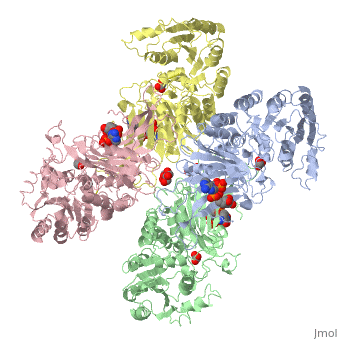1qki
From Proteopedia
(Difference between revisions)
| Line 3: | Line 3: | ||
== Structural highlights == | == Structural highlights == | ||
<table><tr><td colspan='2'>[[1qki]] is a 8 chain structure with sequence from [http://en.wikipedia.org/wiki/Homo_sapiens Homo sapiens]. Full crystallographic information is available from [http://oca.weizmann.ac.il/oca-bin/ocashort?id=1QKI OCA]. For a <b>guided tour on the structure components</b> use [http://oca.weizmann.ac.il/oca-docs/fgij/fg.htm?mol=1QKI FirstGlance]. <br> | <table><tr><td colspan='2'>[[1qki]] is a 8 chain structure with sequence from [http://en.wikipedia.org/wiki/Homo_sapiens Homo sapiens]. Full crystallographic information is available from [http://oca.weizmann.ac.il/oca-bin/ocashort?id=1QKI OCA]. For a <b>guided tour on the structure components</b> use [http://oca.weizmann.ac.il/oca-docs/fgij/fg.htm?mol=1QKI FirstGlance]. <br> | ||
| - | </td></tr><tr><td class="sblockLbl"><b>[[Ligand|Ligands:]]</b></td><td class="sblockDat"><scene name='pdbligand=GOA:GLYCOLIC+ACID'>GOA</scene>, <scene name='pdbligand=GOL:GLYCEROL'>GOL</scene>, <scene name='pdbligand=NAP:NADP+NICOTINAMIDE-ADENINE-DINUCLEOTIDE+PHOSPHATE'>NAP</scene>< | + | </td></tr><tr id='ligand'><td class="sblockLbl"><b>[[Ligand|Ligands:]]</b></td><td class="sblockDat"><scene name='pdbligand=GOA:GLYCOLIC+ACID'>GOA</scene>, <scene name='pdbligand=GOL:GLYCEROL'>GOL</scene>, <scene name='pdbligand=NAP:NADP+NICOTINAMIDE-ADENINE-DINUCLEOTIDE+PHOSPHATE'>NAP</scene></td></tr> |
| - | <tr><td class="sblockLbl"><b>[[Related_structure|Related:]]</b></td><td class="sblockDat">[[1dpg|1dpg]], [[2dpg|2dpg]]</td></tr> | + | <tr id='related'><td class="sblockLbl"><b>[[Related_structure|Related:]]</b></td><td class="sblockDat">[[1dpg|1dpg]], [[2dpg|2dpg]]</td></tr> |
| - | <tr><td class="sblockLbl"><b>[[Gene|Gene:]]</b></td><td class="sblockDat">G6PD ([http://www.ncbi.nlm.nih.gov/Taxonomy/Browser/wwwtax.cgi?mode=Info&srchmode=5&id=9606 Homo sapiens])</td></tr> | + | <tr id='gene'><td class="sblockLbl"><b>[[Gene|Gene:]]</b></td><td class="sblockDat">G6PD ([http://www.ncbi.nlm.nih.gov/Taxonomy/Browser/wwwtax.cgi?mode=Info&srchmode=5&id=9606 Homo sapiens])</td></tr> |
| - | <tr><td class="sblockLbl"><b>Activity:</b></td><td class="sblockDat"><span class='plainlinks'>[http://en.wikipedia.org/wiki/Glucose-6-phosphate_dehydrogenase Glucose-6-phosphate dehydrogenase], with EC number [http://www.brenda-enzymes.info/php/result_flat.php4?ecno=1.1.1.49 1.1.1.49] </span></td></tr> | + | <tr id='activity'><td class="sblockLbl"><b>Activity:</b></td><td class="sblockDat"><span class='plainlinks'>[http://en.wikipedia.org/wiki/Glucose-6-phosphate_dehydrogenase Glucose-6-phosphate dehydrogenase], with EC number [http://www.brenda-enzymes.info/php/result_flat.php4?ecno=1.1.1.49 1.1.1.49] </span></td></tr> |
| - | <tr><td class="sblockLbl"><b>Resources:</b></td><td class="sblockDat"><span class='plainlinks'>[http://oca.weizmann.ac.il/oca-docs/fgij/fg.htm?mol=1qki FirstGlance], [http://oca.weizmann.ac.il/oca-bin/ocaids?id=1qki OCA], [http://www.rcsb.org/pdb/explore.do?structureId=1qki RCSB], [http://www.ebi.ac.uk/pdbsum/1qki PDBsum]</span></td></tr> | + | <tr id='resources'><td class="sblockLbl"><b>Resources:</b></td><td class="sblockDat"><span class='plainlinks'>[http://oca.weizmann.ac.il/oca-docs/fgij/fg.htm?mol=1qki FirstGlance], [http://oca.weizmann.ac.il/oca-bin/ocaids?id=1qki OCA], [http://www.rcsb.org/pdb/explore.do?structureId=1qki RCSB], [http://www.ebi.ac.uk/pdbsum/1qki PDBsum]</span></td></tr> |
| - | <table> | + | </table> |
== Disease == | == Disease == | ||
[[http://www.uniprot.org/uniprot/G6PD_HUMAN G6PD_HUMAN]] Defects in G6PD are the cause of chronic non-spherocytic hemolytic anemia (CNSHA) [MIM:[http://omim.org/entry/305900 305900]]. Deficiency of G6PD is associated with hemolytic anemia in two different situations. First, in areas in which malaria has been endemic, G6PD-deficiency alleles have reached high frequencies (1% to 50%) and deficient individuals, though essentially asymptomatic in the steady state, have a high risk of acute hemolytic attacks. Secondly, sporadic cases of G6PD deficiency occur at a very low frequencies, and they usually present a more severe phenotype. Several types of CNSHA are recognized. Class-I variants are associated with severe NSHA; class-II have an activity <10% of normal; class-III have an activity of 10% to 60% of normal; class-IV have near normal activity.<ref>PMID:1611091</ref> | [[http://www.uniprot.org/uniprot/G6PD_HUMAN G6PD_HUMAN]] Defects in G6PD are the cause of chronic non-spherocytic hemolytic anemia (CNSHA) [MIM:[http://omim.org/entry/305900 305900]]. Deficiency of G6PD is associated with hemolytic anemia in two different situations. First, in areas in which malaria has been endemic, G6PD-deficiency alleles have reached high frequencies (1% to 50%) and deficient individuals, though essentially asymptomatic in the steady state, have a high risk of acute hemolytic attacks. Secondly, sporadic cases of G6PD deficiency occur at a very low frequencies, and they usually present a more severe phenotype. Several types of CNSHA are recognized. Class-I variants are associated with severe NSHA; class-II have an activity <10% of normal; class-III have an activity of 10% to 60% of normal; class-IV have near normal activity.<ref>PMID:1611091</ref> | ||
| Line 37: | Line 37: | ||
[[Category: Glucose-6-phosphate dehydrogenase]] | [[Category: Glucose-6-phosphate dehydrogenase]] | ||
[[Category: Homo sapiens]] | [[Category: Homo sapiens]] | ||
| - | [[Category: Adams, M J | + | [[Category: Adams, M J]] |
| - | [[Category: Au, S W.N | + | [[Category: Au, S W.N]] |
| - | [[Category: Gover, S | + | [[Category: Gover, S]] |
| - | [[Category: Lam, V M.S | + | [[Category: Lam, V M.S]] |
[[Category: Glucose metabolism]] | [[Category: Glucose metabolism]] | ||
[[Category: Oxidoreductase]] | [[Category: Oxidoreductase]] | ||
[[Category: Oxidoredutase]] | [[Category: Oxidoredutase]] | ||
Revision as of 07:53, 6 January 2015
X-RAY STRUCTURE OF HUMAN GLUCOSE 6-PHOSPHATE DEHYDROGENASE (VARIANT CANTON R459L) COMPLEXED WITH STRUCTURAL NADP+
| |||||||||||


